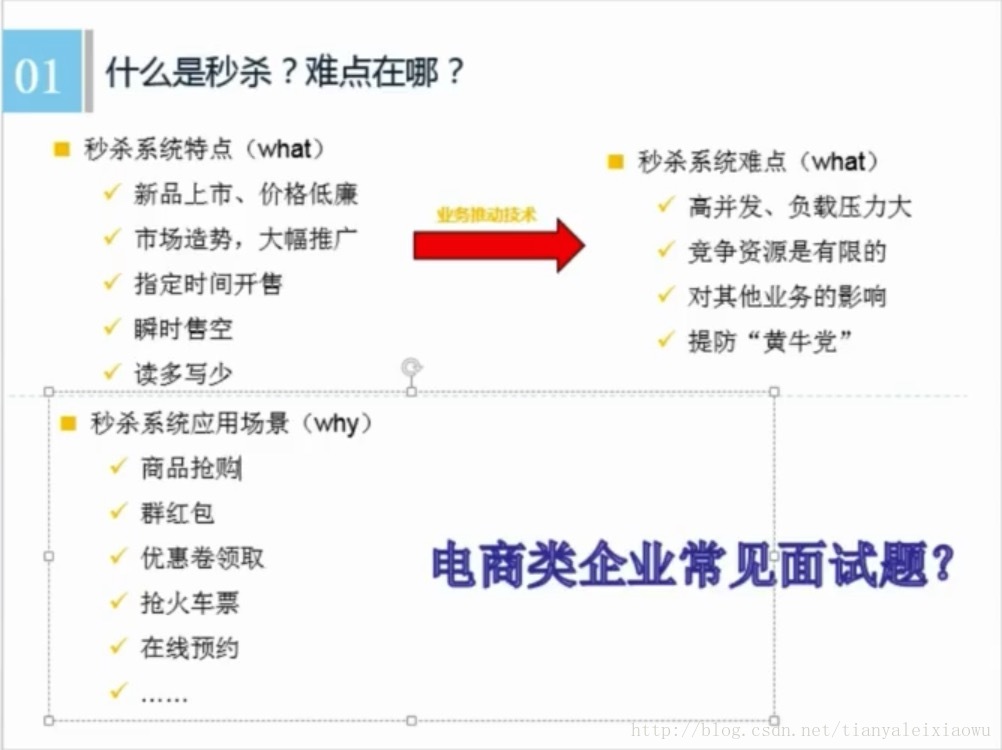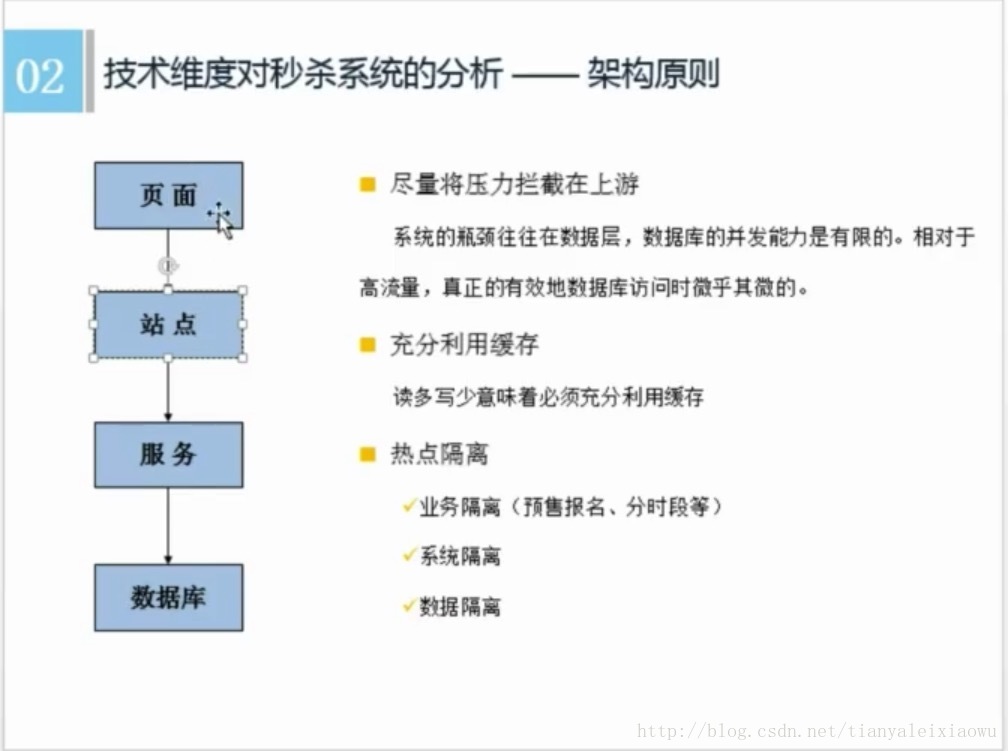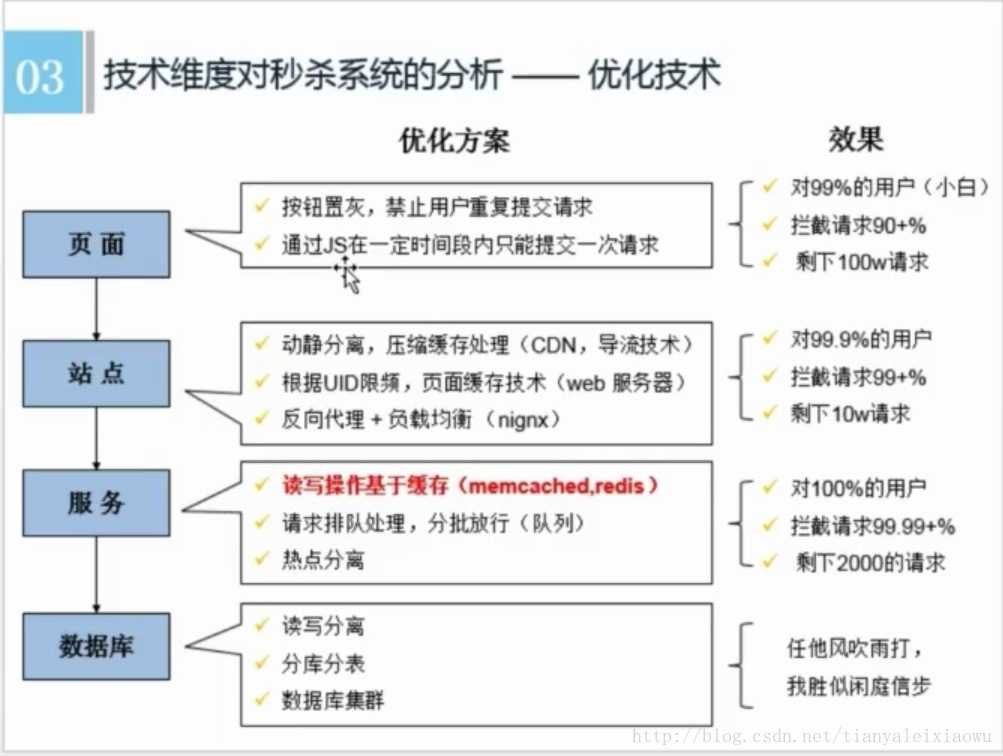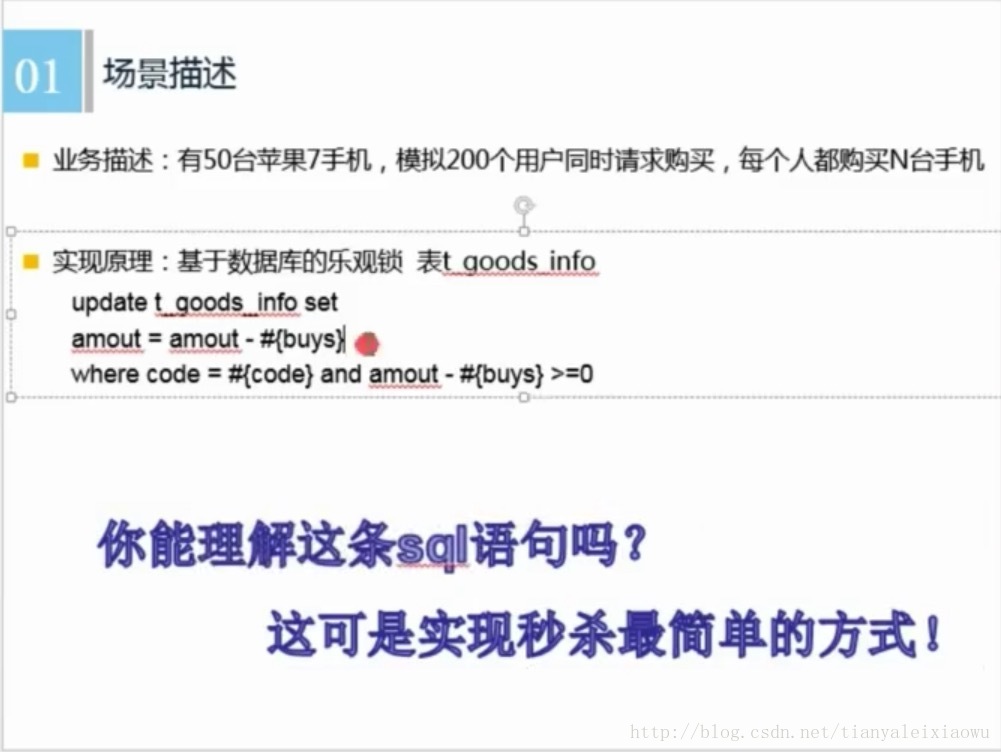本文根据动脑学院的一节类似的课程,改编实现。分别使用DB和redis来完成。


隔离的解释
业务隔离:将秒杀业务独立出来,尽量不与其他业务关联,以减少对其他业务的依赖性。譬如秒杀业务只保留用户id,商品id,数量等重要属性,通过中间件发送给业务系统,完成后续的处理。
系统隔离:将秒杀业务单独部署,以减少对其他业务服务器的压力。
数据隔离:由于秒杀对DB的压力很大,将DB单独部署,不与其他业务DB放一起,避免对DB的压力。


本篇讲使用DB完成秒杀系统。下一篇使用redis完成持久层。
一 初始化项目
以Springboot,mysql,jpa为技术方案。
新建Springboot项目,pom如下
<?xml version="1.0" encoding="UTF-8"?> <project xmlns="http://maven.apache.org/POM/4.0.0" xmlns:xsi="http://www.w3.org/2001/XMLSchema-instance" xsi:schemaLocation="http://maven.apache.org/POM/4.0.0 http://maven.apache.org/xsd/maven-4.0.0.xsd"> <modelVersion>4.0.0</modelVersion> <groupId>com.tianyalei</groupId> <artifactId>common</artifactId> <version>0.0.1-SNAPSHOT</version> <packaging>jar</packaging> <name>common</name> <description>Demo project for Spring Boot</description> <parent> <groupId>org.springframework.boot</groupId> <artifactId>spring-boot-starter-parent</artifactId> <version>1.5.2.RELEASE</version> <relativePath/> <!-- lookup parent from repository --> </parent> <properties> <project.build.sourceEncoding>UTF-8</project.build.sourceEncoding> <project.reporting.outputEncoding>UTF-8</project.reporting.outputEncoding> <java.version>1.8</java.version> </properties> <dependencies> <dependency> <groupId>org.springframework.boot</groupId> <artifactId>spring-boot-devtools</artifactId> <optional>true</optional><!-- optional=true,依赖不会传递,该项目依赖devtools;之后依赖myboot项目的项目如果想要使用devtools,需要重新引入 --> </dependency> <dependency> <groupId>org.springframework.boot</groupId> <artifactId>spring-boot-starter-data-jpa</artifactId> </dependency> <dependency> <groupId>org.springframework.boot</groupId> <artifactId>spring-boot-starter-data-redis</artifactId> </dependency> <dependency> <groupId>mysql</groupId> <artifactId>mysql-connector-java</artifactId> <scope>runtime</scope> </dependency> <dependency> <groupId>com.alibaba</groupId> <artifactId>druid</artifactId> <version>1.0.18</version> </dependency> <dependency> <groupId>org.springframework.boot</groupId> <artifactId>spring-boot-starter-test</artifactId> <scope>test</scope> </dependency> </dependencies> <build> <plugins> <plugin> <groupId>org.springframework.boot</groupId> <artifactId>spring-boot-maven-plugin</artifactId> </plugin> </plugins> </build> </project>
javaBean
package com.tianyalei.model; import javax.persistence.*; /** * Created by wuwf on 17/7/5. */ @Entity public class GoodInfo { @Id @GeneratedValue(strategy = GenerationType.AUTO) private Integer id; //数量 private int amount; //商品编码 @Column(unique = true) private String code; public Integer getId() { return id; } public void setId(Integer id) { this.id = id; } public int getAmount() { return amount; } public void setAmount(int amount) { this.amount = amount; } public String getCode() { return code; } public void setCode(String code) { this.code = code; } }
dao层,注意一下sql语句,where条件中的amount - count >= 0是关键,该语句能严格保证不超卖。
package com.tianyalei.repository; import com.tianyalei.model.GoodInfo; import org.springframework.data.jpa.repository.Modifying; import org.springframework.data.jpa.repository.Query; import org.springframework.data.repository.CrudRepository; /** * Created by admin on 17/7/5. */ public interface GoodInfoRepository extends CrudRepository<GoodInfo, Integer> { @Query("update GoodInfo set amount = amount - ?2 where code = ?1 and amount - ?2 >= 0") @Modifying int updateAmount(String code, int count); }
service接口
package com.tianyalei.service; import com.tianyalei.model.GoodInfo; /** * Created by wuwf on 17/7/5. */ public interface GoodInfoService { void add(GoodInfo goodInfo); void delete(GoodInfo goodInfo); int update(String code, int count); }
Service实现类
package com.tianyalei.service; import com.tianyalei.model.GoodInfo; import com.tianyalei.repository.GoodInfoRepository; import org.springframework.beans.factory.annotation.Autowired; import org.springframework.stereotype.Service; import org.springframework.transaction.annotation.Transactional; /** * Created by wuwf on 17/7/5. */ @Service("db") public class GoodInfoDbService implements GoodInfoService { @Autowired private GoodInfoRepository goodInfoRepository; @Transactional public int update(String code, int count) { return goodInfoRepository.updateAmount(code, count); } public void add(GoodInfo goodInfo) { goodInfoRepository.save(goodInfo); } public void delete(GoodInfo goodInfo) { goodInfoRepository.deleteAll(); } }
yml配置文件
spring: jpa: database: mysql show-sql: true hibernate: ddl-auto: update datasource: type: com.alibaba.druid.pool.DruidDataSource driver-class-name: com.mysql.jdbc.Driver url: jdbc:mysql://localhost:3306/test username: root password: redis: host: localhost port: 6379 password: pool: max-active: 8 max-idle: 8 min-idle: 0 max-wait: 10000 profiles: active: dev server: port: 8080
以上即是基本配置。
二 模拟并发访问抢购
新建junit测试类
package com.tianyalei; import com.tianyalei.model.GoodInfo; import com.tianyalei.service.GoodInfoService; import org.junit.After; import org.junit.Before; import org.junit.Test; import org.junit.runner.RunWith; import org.springframework.boot.test.context.SpringBootTest; import org.springframework.test.context.junit4.SpringRunner; import javax.annotation.Resource; import java.util.ArrayList; import java.util.List; import java.util.concurrent.CountDownLatch; /** * Created by wuwf on 17/7/5. */ @RunWith(SpringRunner.class) @SpringBootTest public class MyTest { @Resource(name = "db") private GoodInfoService service; private String goodCode = "iphone7"; /** * 机器总数量 */ private int goodAmount = 100; /** * 并发量 */ private int threadNum = 200; //销售量 private int goodSale = 0; //买成功的数量 private int accountNum = 0; //买成功的人的ID集合 private List<Integer> successUsers = new ArrayList<>(); private GoodInfo goodInfo; /*当创建 CountDownLatch 对象时,对象使用构造函数的参数来初始化内部计数器。每次调用 countDown() 方法, CountDownLatch 对象内部计数器减一。当内部计数器达到0时, CountDownLatch 对象唤醒全部使用 await() 方法睡眠的线程们。*/ private CountDownLatch countDownLatch = new CountDownLatch(threadNum); @Test public void contextLoads() { for (int i = 0; i < threadNum; i++) { new Thread(new UserRequest(goodCode, 7, i)).start(); countDownLatch.countDown(); } //让主线程等待200个线程执行完,休息2秒,不休息的话200条线程还没执行完,就打印了 try { Thread.sleep(2000); } catch (InterruptedException e) { e.printStackTrace(); } System.out.println("-----------购买成功的用户数量----------为" + accountNum); System.out.println("-----------销售量--------------------为" + goodSale); System.out.println("-----------剩余数量------------------为" + (goodAmount - goodSale)); System.out.println(successUsers); } private class UserRequest implements Runnable { private String code; private int buyCount; private int userId; public UserRequest(String code, int buyCount, int userId) { this.code = code; this.buyCount = buyCount; this.userId = userId; } @Override public void run() { try { //让线程等待,等200个线程创建完一起执行 countDownLatch.await(); } catch (InterruptedException e) { e.printStackTrace(); } //如果更新数据库成功,也就代表购买成功了 if (service.update(code, buyCount) > 0) { //对service加锁,因为很多线程在访问同一个service对象,不加锁将导致购买成功的人数少于预期,且数量不对,可自行测试 synchronized (service) { //销售量 goodSale += buyCount; accountNum++; //收录购买成功的人 successUsers.add(userId); } } } } @Before public void add() { goodInfo = new GoodInfo(); goodInfo.setCode(goodCode); goodInfo.setAmount(goodAmount); service.add(goodInfo); } @After public void delete() { service.delete(goodInfo); } }
注意,由于是模拟并发,需要保证200个线程同时启动去访问数据库,所以使用了CountDownLatch类,在调用UserRequest线程的start方法后,会先进入await状态,等待200个线程创建完毕后,一起执行。
注意,由于是多线程操作service,必然导致数据不同步,所以需要对service加synchronize锁,来保证service的update方法能够正确执行。如果不加,可以自行测试,会导致少卖。
运行该测试类,看打印的结果。

可以多次运行,并修改每个人的购买数量、总商品数量、线程数,看看结果是否正确。
如修改为每人购买8个

mysql支持的并发访问量有限,倘若并发量较小,可以采用上面的update的sql就能控制住,倘若量大,可以考虑使用nosql。
下一篇讲一下redis模拟的方式。










